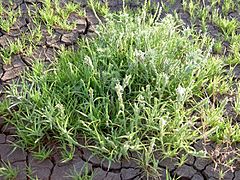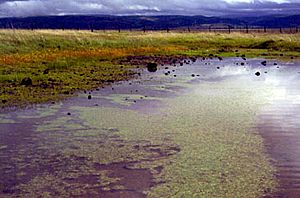Tuctoria facts for kids
Quick facts for kids Tuctoria |
|
|---|---|
 |
|
| Tuctoria greenei | |
| Scientific classification | |
| Kingdom: | |
| (unranked): | |
| (unranked): | |
| (unranked): | |
| Order: | |
| Family: | |
| Tribe: |
Orcuttieae
|
| Genus: |
Tuctoria
J.Reeder
|
| Type species | |
| Tuctoria fragilis (Swallen) J.Reeder
|
|
| Species | |
|
T. fragilis |
|
Tuctoria is a group of three types of grass plants. People often call them Spiralgrass. These grasses grow in clumps and are found in special seasonal ponds called vernal pools. You can find them in central California in the United States and in Baja California, Mexico.
These plants are annuals, which means they live for only one year. Their seeds start to grow underwater in the spring and stay submerged for several weeks. After the pools dry up, the grasses grow new leaves. These new leaves last for about one to two months until the plants make flowers and fruits.
Contents
What is Tuctoria?
Tuctoria is a genus (a group of closely related species) of grass. It belongs to the Poaceae family, which is the grass family. There are three known species in this genus.
How Tuctoria Got Its Name
The group Tuctoria was officially named by a scientist named John R. Reeder in 1982. It's part of a larger group of grasses called the Orcuttieae tribe. Before 1982, all three Tuctoria species were thought to be part of another group called Orcuttia.
However, John Reeder noticed that these three species were more alike to each other than to other Orcuttia species. They shared special features like their chromosome numbers and how their flower parts (called spikelets) are arranged in a spiral. They also have special parts in their seeds. Because of these shared features, Reeder decided they should be in their own group, Tuctoria. Interestingly, the name Tuctoria is just the letters of Orcuttia mixed up!
What Tuctoria Plants Look Like
Tuctoria plants have their flower parts, called spikelets, arranged in a spiral shape along the main stem. The outer parts of the flowers, called lemmas, can be smooth or have tiny teeth. They often have a short, sharp tip in the middle.
Unlike some other related grasses, the whole flower cluster is not shaped like a cylinder. The spikelets are flattened from the sides. The seeds of Tuctoria are not sticky, and you can see the brown part of the seed (the embryo) through its lighter outer layer.
Types of Tuctoria Species
There are three different species of Tuctoria:
- Tuctoria fragilis: This species was first described in 1944. It is found in Baja California, Mexico. Its stems can grow up to 50 centimeters (about 20 inches) long. It often has several flower clusters growing from its upper parts. Its seeds are somewhat pear-shaped and wrinkled.
- Tuctoria greenei: This species is found in California. Its stems are shorter, usually less than 20 centimeters (about 8 inches) long. It has one flower cluster at the very top of its stem. Its seeds are about 2 millimeters (0.08 inches) long, oblong, and wrinkled.
- Tuctoria mucronata: This species grows only in Solano County, Northern California, south of Dixon. Its flower cluster is partly hidden by the upper leaves. Its lemmas (flower parts) gradually narrow to a sharp tip. Its seeds are smooth and measure about 3 millimeters (0.12 inches) long.
Where Tuctoria Grows and How It Survives

Tuctoria species are found only in seasonal pools in the southwestern United States. These pools fill with water during the rainy season and then dry up.
Like all plants in their tribe, Tuctoria plants start growing underwater. When the pools dry out, the plants change. They grow new leaves that are better suited for dry land. These new leaves have a special way of doing photosynthesis (making food from sunlight) called C-4 photosynthesis. This helps the plants survive the long, dry periods when the pools are gone.
If there isn't much rain in a year, the seeds of Tuctoria can stay dormant (asleep) in the soil. They will only start to grow when there's enough rain to fill the pool basins again. For T. greenei, the seeds need two things to start growing: no oxygen in the water and some light. This helps the plant make sure it only starts to grow when the pools are full of water. If there's not much rain, the soil might not have enough water to become oxygen-free, which stops the seeds from growing too early.
Tuctoria greenei is a plant that needs special protection in California. This is because the vernal pools where it lives are disappearing. They are being lost due to farms and cities expanding.
See also
 In Spanish: Tuctoria para niños
In Spanish: Tuctoria para niños

